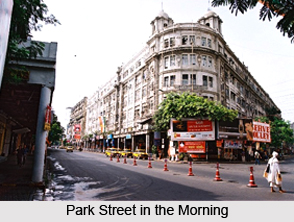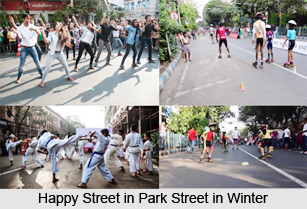 Park Street which is officially known as Mother Teresa Sarani, is a popular area in Kolkata, West Bengal. It is the busy office area in day time and in night it turns into a place of chills.
Park Street which is officially known as Mother Teresa Sarani, is a popular area in Kolkata, West Bengal. It is the busy office area in day time and in night it turns into a place of chills.
History of Park Street
Park Street was earlier known as Burial Ground Road. It is a famous thoroughfare in the city of Kolkata. The street runs through what was a deer park of Sir Elijah Impey, Chief Justice of the Supreme Court in Calcutta from 1773 to 1789, hence the earlier name. Its current official name was given by Kolkata Municipal Corporation in honour of Mother Teresa. In the 1970s and 1980s much of Kolkata`s night life took place at Park Street. Many noted musicians had played at popular restaurants, cafes and bars. Even before that, in the 1940s, 50s and 60s the prolific night life was centred on Park Street. Park Street remains the foremost dining region with many restaurants and pubs. It is often known as "Food Street" and "The Street that Never Sleeps".
Extension of Park Street
Park Street originates from Chowringhee Road (J L Nehru Road) and connects to Park Circus 7 point crossing in a south eastern direction. The portion of Park Street between Chowringhee Road and Mullick Bazar has been one of the city`s attractions for years. Several important roads originate from intersect at Park Street in the northward and southward directions, namely Russell Street, Middleton Row, Camac Street, Wood Street, Loudon Street and Rawdon Street towards the South and Free School Street, Rafi Ahmed Kidwai Road towards the North. Park Street also intersects AJC Bose Road at Mullick Bazar crossing and eventually goes to Park Circus from where other major roads such as Syed Amir Ali Avenue, Darga Road, Park Circus Connector starts and connects to important areas such as Ballygunge, E M Bypass and CIT Road Kolkata.
Building of Park Street
Park Street has many notable shops and several notable buildings such as the Asiatic Society, St. Xavier`s College, Calcutta, a Seventh-day Adventist Church, and the South Park Street Cemetery has cenotaphs and tombs of prominent figures from the British East India Company and Kolkata`s European population.
 Recreational Zone of Park Street
Recreational Zone of Park Street
Park Street has been the recreation zone for Kolkata people since the British era. However, in the last 20 years, many new restaurants, malls, 5-star hotels and nightclubs have opened in other areas of the city and Park Street has lost much of its earlier attraction as being the entertainment hub of Kolkata. However, it is still one of the prime commercial and entertainment zones of the city. Park Street is traditionally decorated with lights on Diwali, Christmas Day and New Year`s Eve.
Related Articles
Capital Cities of India
History of Kolkata
Kolkata, Indian City, West Bengal
Culture of Kolkata
Economy of Kolkata
West Bengal, Indian State
Monuments in Kolkata, West Bengal Monuments
History of Bengali Theatre
Birla Planetarium, Kolkata
British Empire in India
Impact of British Rule in India
British Military Architecture in India
British East India Company
Mother Teresa
Tourism In Kolkata
The Maidan, Kolkata
Indian Street Theatre
Taltala, Kolkata, West Bengal
British Monuments in India
Monuments of West Bengal



















